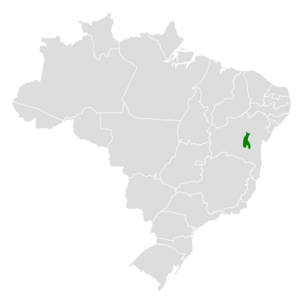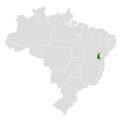Diamantina tapaculo facts for kids
Quick facts for kids Diamantina tapaculo |
|
|---|---|
 |
|
| at Chapada Diamantina, Bahia, Brazil | |
| Conservation status | |
| Scientific classification | |
| Genus: |
Scytalopus
|
| Species: |
diamantinensis
|
 |
|
The Diamantina tapaculo (Scytalopus diamantinensis) is a small, shy bird that belongs to the Rhinocryptidae family. These birds are often called "tapaculos" because of their unique calls. This particular species is found only in a special part of northeastern Brazil. It was discovered and described as a new species in 2007.
Contents
What is the Diamantina Tapaculo?
The Diamantina tapaculo is a type of bird that lives only in one specific area. It's considered an endemic species, meaning it's native to and found only in that region. Scientists are still learning a lot about this bird, especially since it was only recently identified.
How was the Diamantina Tapaculo discovered?
The Diamantina tapaculo was officially described as a new species in 2007. Before that, it might have been mistaken for other similar birds. Scientists study birds' looks, sounds, and DNA to figure out if they are different species. When it was first described, many thought it was very closely related to another bird called the Planalto tapaculo. Some big bird organizations, like the American Ornithological Society, agree with this idea. However, other groups, like the International Ornithological Congress, are still looking into it.
What does the Diamantina Tapaculo look like?
This little bird is about 10 to 11 centimeters (4 to 4.3 inches) long. That's roughly the length of a small smartphone! It weighs about 15 grams (0.5 ounces), which is lighter than a few quarters.
How can you tell it apart from other birds?
The Diamantina tapaculo looks a lot like the Planalto tapaculo.
- Males: Their upper body is mostly dark gray. Their belly and chest are a lighter gray. The sides of their body are a buff (light brownish-yellow) color with dark stripes. These stripes are important because they help tell it apart from another similar bird, the mouse-colored tapaculo, which doesn't have these stripes.
- Females: They tend to be a bit browner than the males.
Where does the Diamantina Tapaculo live?
The Diamantina tapaculo lives only in a place called the Chapada Diamantina in the Bahia state of Brazil. This area is known for its beautiful landscapes.
What kind of home does it prefer?
This bird likes to live in dense, thick patches of forest. These forest patches are often found within a different type of environment called campo rupestre. This biome is a mix of grasslands and rocky areas. The Diamantina tapaculo lives at elevations ranging from about 850 to 1,600 meters (2,790 to 5,250 feet) above sea level.
How does the Diamantina Tapaculo behave?
Scientists are still learning about the daily life of the Diamantina tapaculo.
What does it eat?
Right now, there isn't much information published about what the Diamantina tapaculo eats. We also don't know much about how it finds its food.
How does it raise its young?
Very little is known about how these birds breed. However, one nest has been found and described.
- The nest was shaped like a bowl.
- It was made of grasses.
- It was hidden inside a crack in a rock.
- Two baby birds were found in this nest.
- Both the mother and father bird helped feed the nestlings.
What does the Diamantina Tapaculo sound like?
The Diamantina tapaculo has a distinct song and call.
- Song: Its song is a simple note that it repeats very quickly. It can keep singing this song for more than a minute! You can sometimes hear recordings of its song online.
- Call: Its call is unique. It's described as a single "tcheep" sound.
Why is the Diamantina Tapaculo endangered?
The IUCN (International Union for Conservation of Nature) has listed the Diamantina tapaculo as an "Endangered" species. This means it's at a high risk of becoming extinct in the wild.
What threatens the Diamantina Tapaculo?
There are several reasons why this bird is in danger:
- Small Home: It lives in a very small area, with fewer than five known locations where it can be found.
- Habitat Loss: The places where it lives are shrinking.
- Natural forests are being cut down to make room for farms, especially for coffee and banana plants.
- Trees are also being cut for firewood, which is used by homes and industries.
- Uncontrolled tourism in the area can also disturb its habitat.
All these activities mean less safe space for the Diamantina tapaculo to live and raise its young. Protecting its habitat is very important for its survival.
Images for kids



